Managing People in Organisations
VerifiedAdded on 2023/01/18
|12
|3321
|24
AI Summary
This document provides insights on managing people in organisations, focusing on Amazon as a case study. It covers topics such as existing organisational structure, culture, comparative models, strengths, weaknesses, and recommendations. Additionally, it discusses the implementation of leadership development and employee motivation in Amazon.
Contribute Materials
Your contribution can guide someone’s learning journey. Share your
documents today.
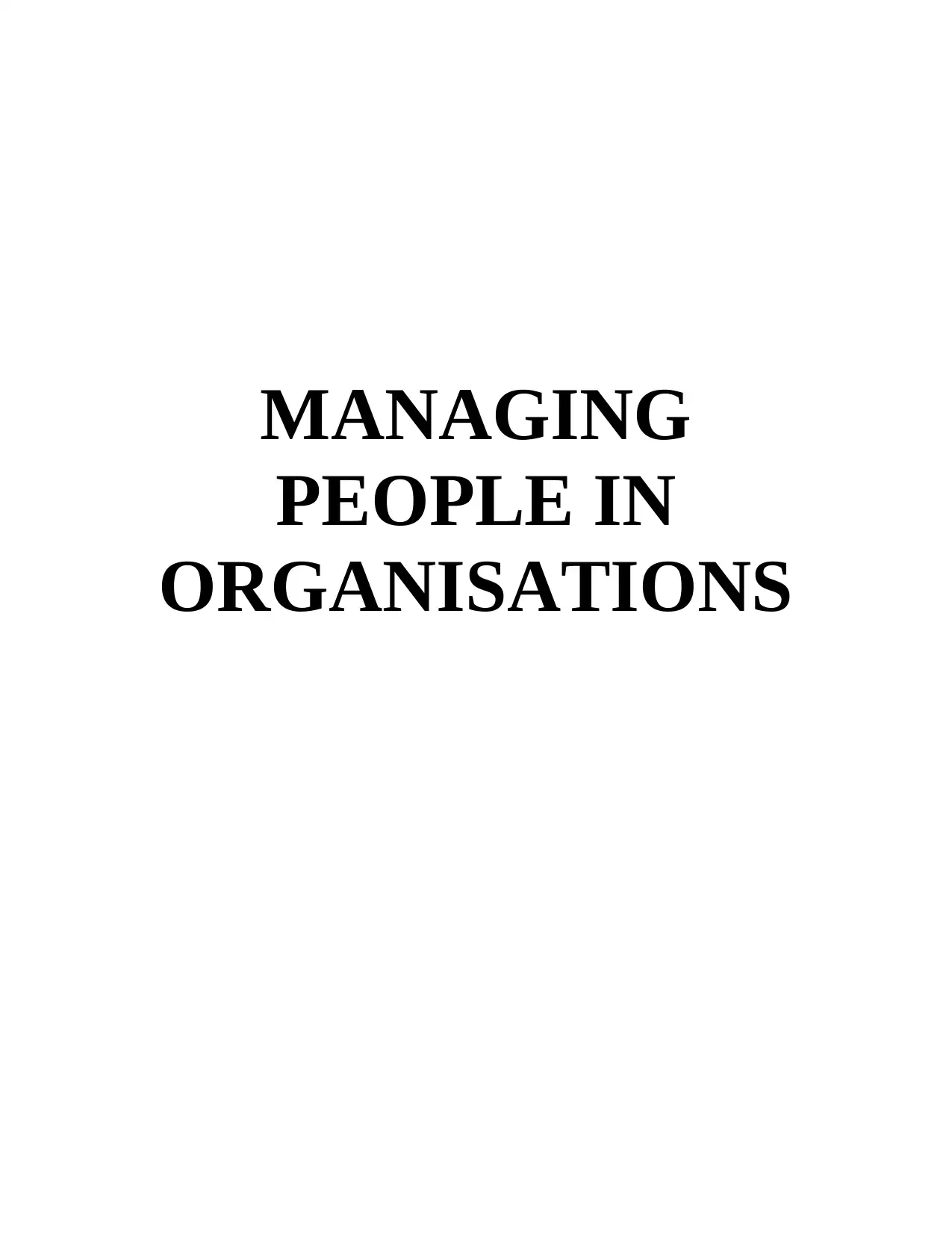
MANAGING
PEOPLE IN
ORGANISATIONS
PEOPLE IN
ORGANISATIONS
Secure Best Marks with AI Grader
Need help grading? Try our AI Grader for instant feedback on your assignments.
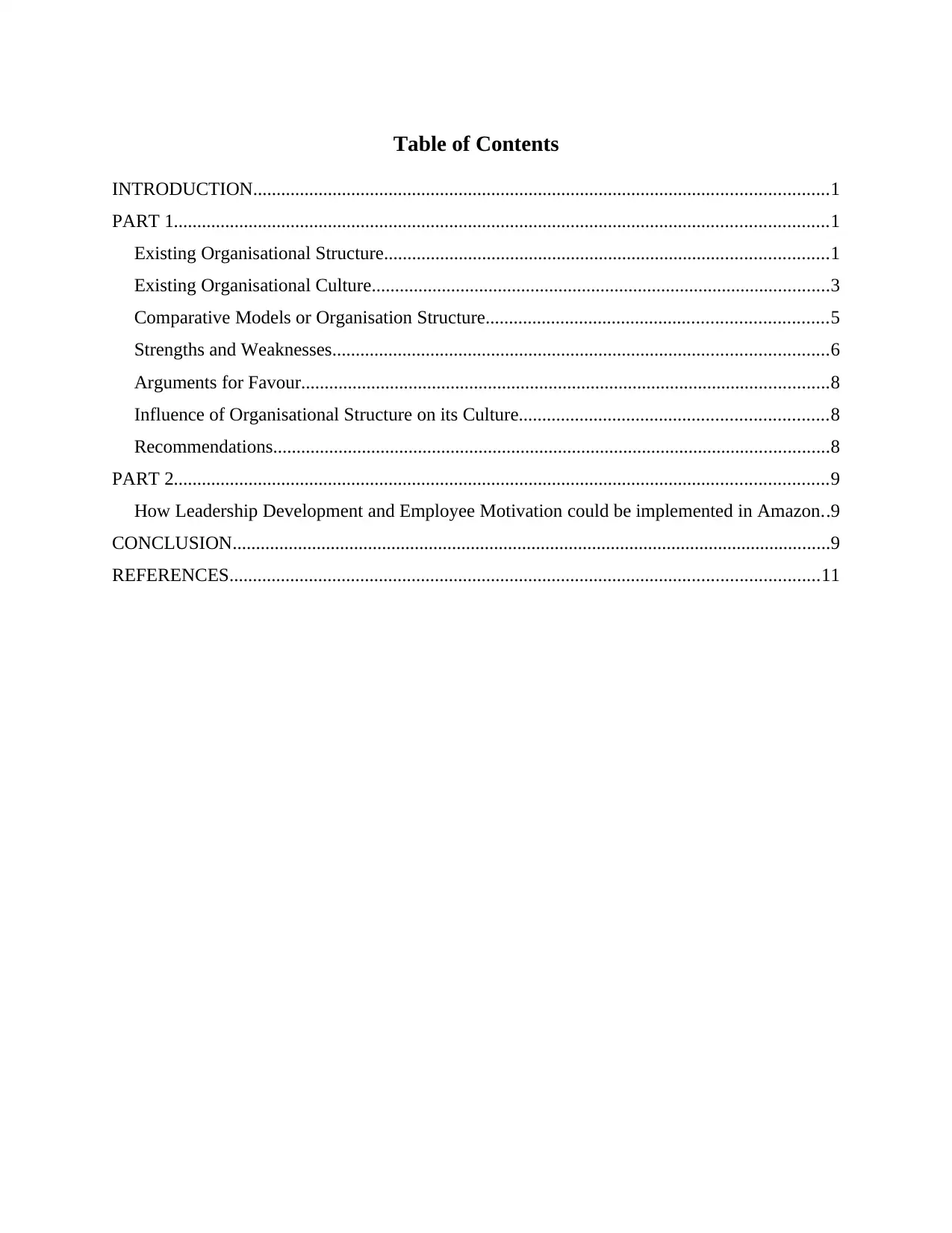
Table of Contents
INTRODUCTION...........................................................................................................................1
PART 1............................................................................................................................................1
Existing Organisational Structure...............................................................................................1
Existing Organisational Culture..................................................................................................3
Comparative Models or Organisation Structure.........................................................................5
Strengths and Weaknesses..........................................................................................................6
Arguments for Favour.................................................................................................................8
Influence of Organisational Structure on its Culture..................................................................8
Recommendations.......................................................................................................................8
PART 2............................................................................................................................................9
How Leadership Development and Employee Motivation could be implemented in Amazon..9
CONCLUSION................................................................................................................................9
REFERENCES..............................................................................................................................11
INTRODUCTION...........................................................................................................................1
PART 1............................................................................................................................................1
Existing Organisational Structure...............................................................................................1
Existing Organisational Culture..................................................................................................3
Comparative Models or Organisation Structure.........................................................................5
Strengths and Weaknesses..........................................................................................................6
Arguments for Favour.................................................................................................................8
Influence of Organisational Structure on its Culture..................................................................8
Recommendations.......................................................................................................................8
PART 2............................................................................................................................................9
How Leadership Development and Employee Motivation could be implemented in Amazon..9
CONCLUSION................................................................................................................................9
REFERENCES..............................................................................................................................11
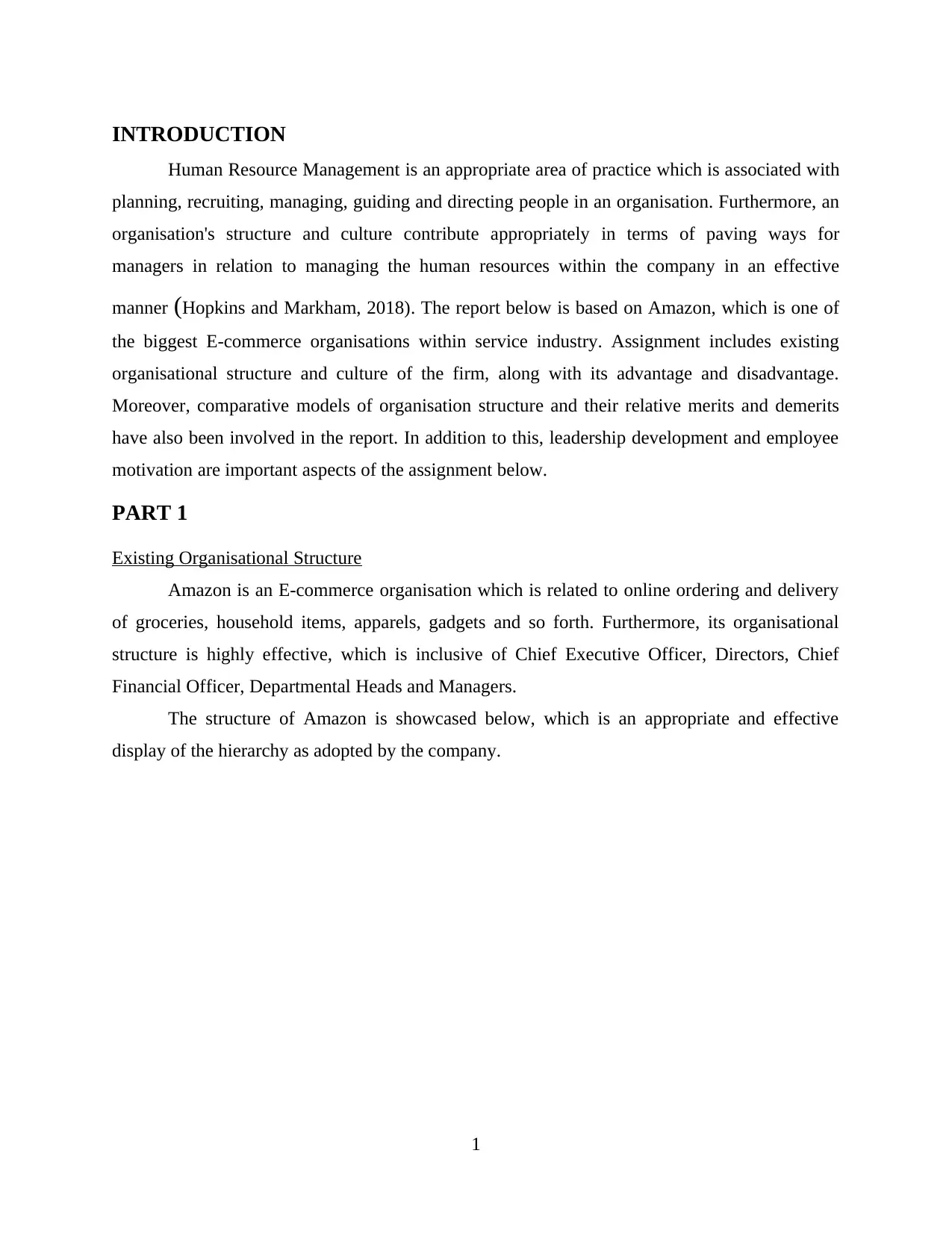
INTRODUCTION
Human Resource Management is an appropriate area of practice which is associated with
planning, recruiting, managing, guiding and directing people in an organisation. Furthermore, an
organisation's structure and culture contribute appropriately in terms of paving ways for
managers in relation to managing the human resources within the company in an effective
manner (Hopkins and Markham, 2018). The report below is based on Amazon, which is one of
the biggest E-commerce organisations within service industry. Assignment includes existing
organisational structure and culture of the firm, along with its advantage and disadvantage.
Moreover, comparative models of organisation structure and their relative merits and demerits
have also been involved in the report. In addition to this, leadership development and employee
motivation are important aspects of the assignment below.
PART 1
Existing Organisational Structure
Amazon is an E-commerce organisation which is related to online ordering and delivery
of groceries, household items, apparels, gadgets and so forth. Furthermore, its organisational
structure is highly effective, which is inclusive of Chief Executive Officer, Directors, Chief
Financial Officer, Departmental Heads and Managers.
The structure of Amazon is showcased below, which is an appropriate and effective
display of the hierarchy as adopted by the company.
1
Human Resource Management is an appropriate area of practice which is associated with
planning, recruiting, managing, guiding and directing people in an organisation. Furthermore, an
organisation's structure and culture contribute appropriately in terms of paving ways for
managers in relation to managing the human resources within the company in an effective
manner (Hopkins and Markham, 2018). The report below is based on Amazon, which is one of
the biggest E-commerce organisations within service industry. Assignment includes existing
organisational structure and culture of the firm, along with its advantage and disadvantage.
Moreover, comparative models of organisation structure and their relative merits and demerits
have also been involved in the report. In addition to this, leadership development and employee
motivation are important aspects of the assignment below.
PART 1
Existing Organisational Structure
Amazon is an E-commerce organisation which is related to online ordering and delivery
of groceries, household items, apparels, gadgets and so forth. Furthermore, its organisational
structure is highly effective, which is inclusive of Chief Executive Officer, Directors, Chief
Financial Officer, Departmental Heads and Managers.
The structure of Amazon is showcased below, which is an appropriate and effective
display of the hierarchy as adopted by the company.
1
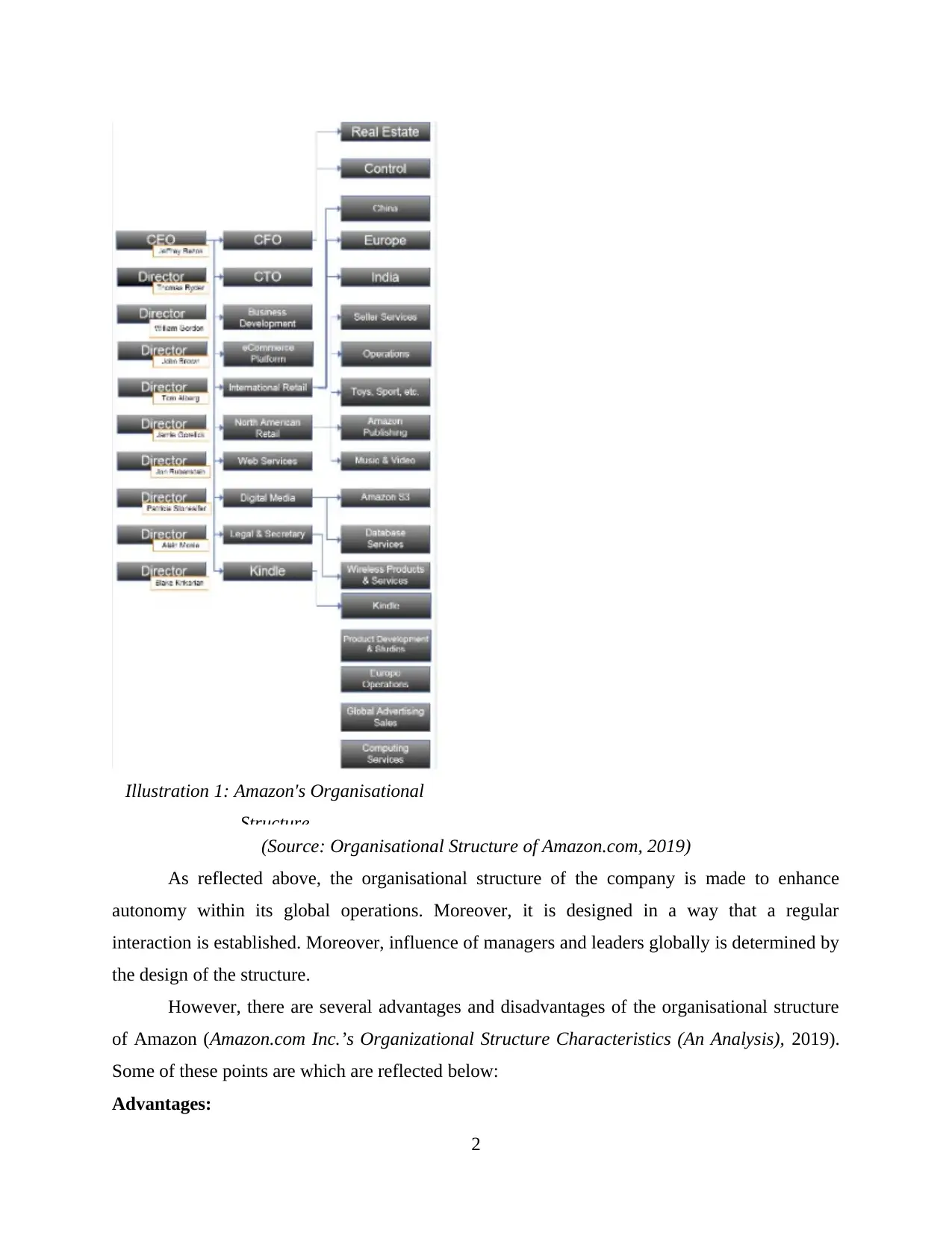
Illustration 1: Amazon's Organisational
Structure
(Source: Organisational Structure of Amazon.com, 2019)
As reflected above, the organisational structure of the company is made to enhance
autonomy within its global operations. Moreover, it is designed in a way that a regular
interaction is established. Moreover, influence of managers and leaders globally is determined by
the design of the structure.
However, there are several advantages and disadvantages of the organisational structure
of Amazon (Amazon.com Inc.’s Organizational Structure Characteristics (An Analysis), 2019).
Some of these points are which are reflected below:
Advantages:
2
Structure
(Source: Organisational Structure of Amazon.com, 2019)
As reflected above, the organisational structure of the company is made to enhance
autonomy within its global operations. Moreover, it is designed in a way that a regular
interaction is established. Moreover, influence of managers and leaders globally is determined by
the design of the structure.
However, there are several advantages and disadvantages of the organisational structure
of Amazon (Amazon.com Inc.’s Organizational Structure Characteristics (An Analysis), 2019).
Some of these points are which are reflected below:
Advantages:
2
Paraphrase This Document
Need a fresh take? Get an instant paraphrase of this document with our AI Paraphraser
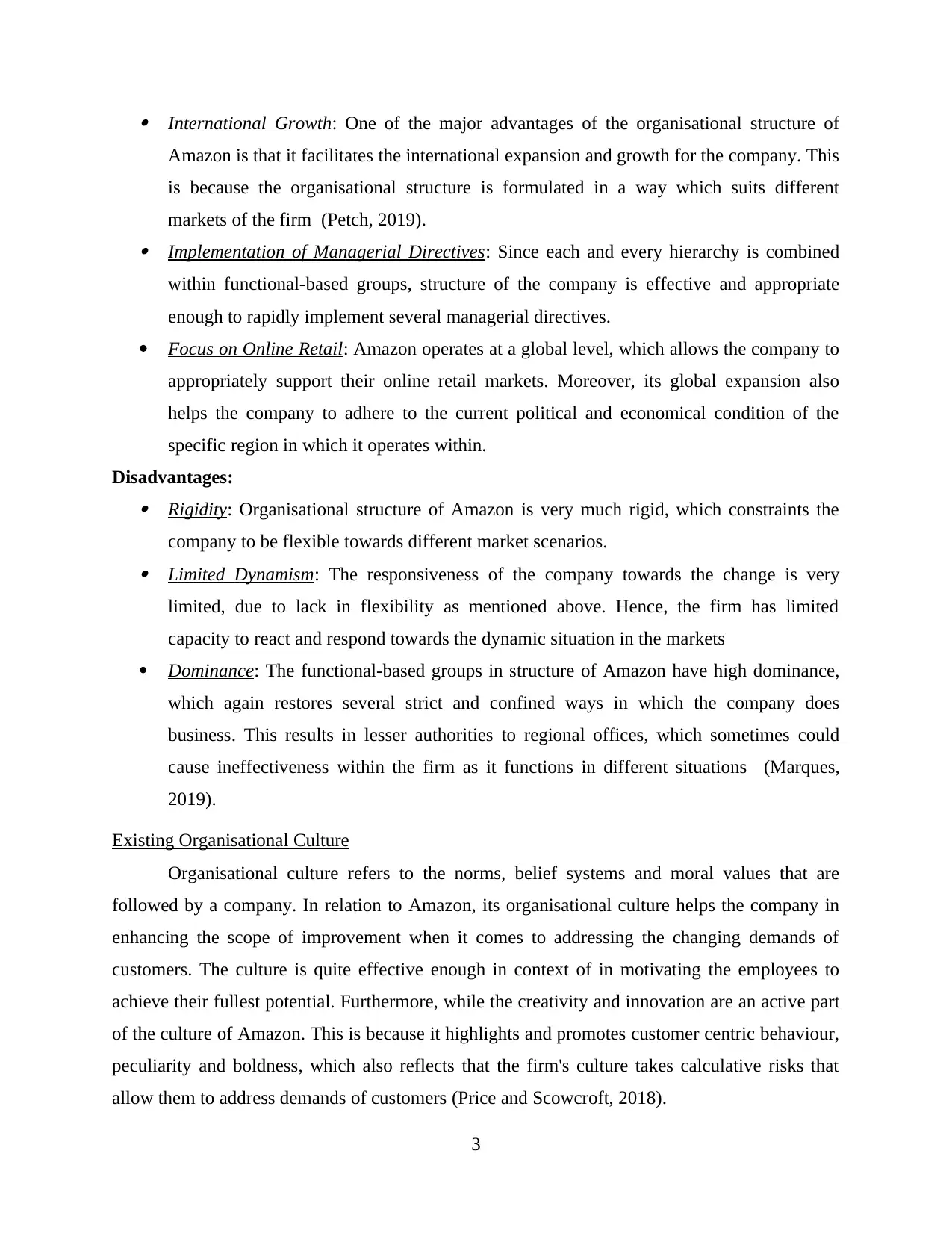
International Growth: One of the major advantages of the organisational structure of
Amazon is that it facilitates the international expansion and growth for the company. This
is because the organisational structure is formulated in a way which suits different
markets of the firm (Petch, 2019). Implementation of Managerial Directives: Since each and every hierarchy is combined
within functional-based groups, structure of the company is effective and appropriate
enough to rapidly implement several managerial directives.
Focus on Online Retail: Amazon operates at a global level, which allows the company to
appropriately support their online retail markets. Moreover, its global expansion also
helps the company to adhere to the current political and economical condition of the
specific region in which it operates within.
Disadvantages: Rigidity: Organisational structure of Amazon is very much rigid, which constraints the
company to be flexible towards different market scenarios. Limited Dynamism: The responsiveness of the company towards the change is very
limited, due to lack in flexibility as mentioned above. Hence, the firm has limited
capacity to react and respond towards the dynamic situation in the markets
Dominance: The functional-based groups in structure of Amazon have high dominance,
which again restores several strict and confined ways in which the company does
business. This results in lesser authorities to regional offices, which sometimes could
cause ineffectiveness within the firm as it functions in different situations (Marques,
2019).
Existing Organisational Culture
Organisational culture refers to the norms, belief systems and moral values that are
followed by a company. In relation to Amazon, its organisational culture helps the company in
enhancing the scope of improvement when it comes to addressing the changing demands of
customers. The culture is quite effective enough in context of in motivating the employees to
achieve their fullest potential. Furthermore, while the creativity and innovation are an active part
of the culture of Amazon. This is because it highlights and promotes customer centric behaviour,
peculiarity and boldness, which also reflects that the firm's culture takes calculative risks that
allow them to address demands of customers (Price and Scowcroft, 2018).
3
Amazon is that it facilitates the international expansion and growth for the company. This
is because the organisational structure is formulated in a way which suits different
markets of the firm (Petch, 2019). Implementation of Managerial Directives: Since each and every hierarchy is combined
within functional-based groups, structure of the company is effective and appropriate
enough to rapidly implement several managerial directives.
Focus on Online Retail: Amazon operates at a global level, which allows the company to
appropriately support their online retail markets. Moreover, its global expansion also
helps the company to adhere to the current political and economical condition of the
specific region in which it operates within.
Disadvantages: Rigidity: Organisational structure of Amazon is very much rigid, which constraints the
company to be flexible towards different market scenarios. Limited Dynamism: The responsiveness of the company towards the change is very
limited, due to lack in flexibility as mentioned above. Hence, the firm has limited
capacity to react and respond towards the dynamic situation in the markets
Dominance: The functional-based groups in structure of Amazon have high dominance,
which again restores several strict and confined ways in which the company does
business. This results in lesser authorities to regional offices, which sometimes could
cause ineffectiveness within the firm as it functions in different situations (Marques,
2019).
Existing Organisational Culture
Organisational culture refers to the norms, belief systems and moral values that are
followed by a company. In relation to Amazon, its organisational culture helps the company in
enhancing the scope of improvement when it comes to addressing the changing demands of
customers. The culture is quite effective enough in context of in motivating the employees to
achieve their fullest potential. Furthermore, while the creativity and innovation are an active part
of the culture of Amazon. This is because it highlights and promotes customer centric behaviour,
peculiarity and boldness, which also reflects that the firm's culture takes calculative risks that
allow them to address demands of customers (Price and Scowcroft, 2018).
3
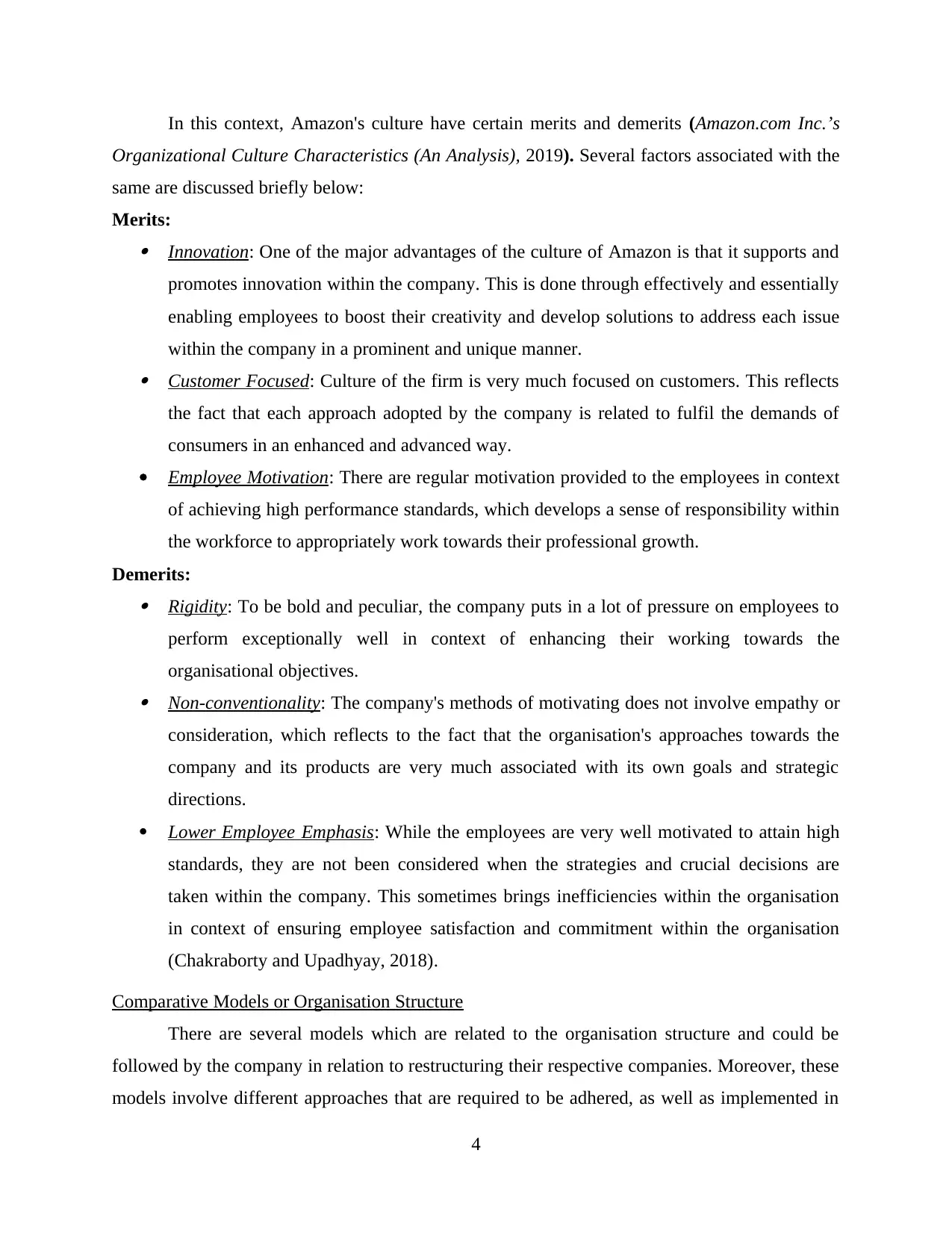
In this context, Amazon's culture have certain merits and demerits (Amazon.com Inc.’s
Organizational Culture Characteristics (An Analysis), 2019). Several factors associated with the
same are discussed briefly below:
Merits: Innovation: One of the major advantages of the culture of Amazon is that it supports and
promotes innovation within the company. This is done through effectively and essentially
enabling employees to boost their creativity and develop solutions to address each issue
within the company in a prominent and unique manner. Customer Focused: Culture of the firm is very much focused on customers. This reflects
the fact that each approach adopted by the company is related to fulfil the demands of
consumers in an enhanced and advanced way.
Employee Motivation: There are regular motivation provided to the employees in context
of achieving high performance standards, which develops a sense of responsibility within
the workforce to appropriately work towards their professional growth.
Demerits: Rigidity: To be bold and peculiar, the company puts in a lot of pressure on employees to
perform exceptionally well in context of enhancing their working towards the
organisational objectives. Non-conventionality: The company's methods of motivating does not involve empathy or
consideration, which reflects to the fact that the organisation's approaches towards the
company and its products are very much associated with its own goals and strategic
directions.
Lower Employee Emphasis: While the employees are very well motivated to attain high
standards, they are not been considered when the strategies and crucial decisions are
taken within the company. This sometimes brings inefficiencies within the organisation
in context of ensuring employee satisfaction and commitment within the organisation
(Chakraborty and Upadhyay, 2018).
Comparative Models or Organisation Structure
There are several models which are related to the organisation structure and could be
followed by the company in relation to restructuring their respective companies. Moreover, these
models involve different approaches that are required to be adhered, as well as implemented in
4
Organizational Culture Characteristics (An Analysis), 2019). Several factors associated with the
same are discussed briefly below:
Merits: Innovation: One of the major advantages of the culture of Amazon is that it supports and
promotes innovation within the company. This is done through effectively and essentially
enabling employees to boost their creativity and develop solutions to address each issue
within the company in a prominent and unique manner. Customer Focused: Culture of the firm is very much focused on customers. This reflects
the fact that each approach adopted by the company is related to fulfil the demands of
consumers in an enhanced and advanced way.
Employee Motivation: There are regular motivation provided to the employees in context
of achieving high performance standards, which develops a sense of responsibility within
the workforce to appropriately work towards their professional growth.
Demerits: Rigidity: To be bold and peculiar, the company puts in a lot of pressure on employees to
perform exceptionally well in context of enhancing their working towards the
organisational objectives. Non-conventionality: The company's methods of motivating does not involve empathy or
consideration, which reflects to the fact that the organisation's approaches towards the
company and its products are very much associated with its own goals and strategic
directions.
Lower Employee Emphasis: While the employees are very well motivated to attain high
standards, they are not been considered when the strategies and crucial decisions are
taken within the company. This sometimes brings inefficiencies within the organisation
in context of ensuring employee satisfaction and commitment within the organisation
(Chakraborty and Upadhyay, 2018).
Comparative Models or Organisation Structure
There are several models which are related to the organisation structure and could be
followed by the company in relation to restructuring their respective companies. Moreover, these
models involve different approaches that are required to be adhered, as well as implemented in
4
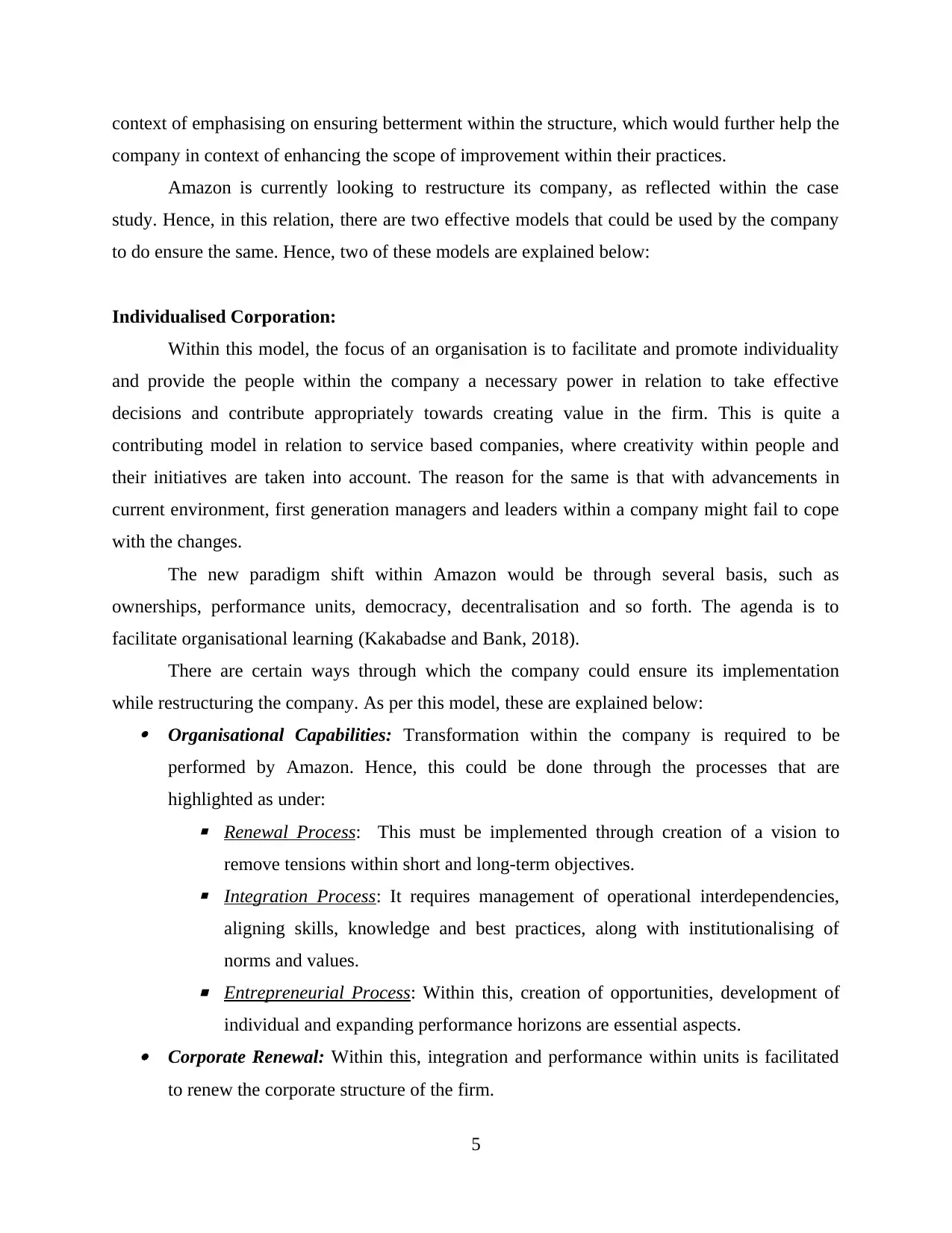
context of emphasising on ensuring betterment within the structure, which would further help the
company in context of enhancing the scope of improvement within their practices.
Amazon is currently looking to restructure its company, as reflected within the case
study. Hence, in this relation, there are two effective models that could be used by the company
to do ensure the same. Hence, two of these models are explained below:
Individualised Corporation:
Within this model, the focus of an organisation is to facilitate and promote individuality
and provide the people within the company a necessary power in relation to take effective
decisions and contribute appropriately towards creating value in the firm. This is quite a
contributing model in relation to service based companies, where creativity within people and
their initiatives are taken into account. The reason for the same is that with advancements in
current environment, first generation managers and leaders within a company might fail to cope
with the changes.
The new paradigm shift within Amazon would be through several basis, such as
ownerships, performance units, democracy, decentralisation and so forth. The agenda is to
facilitate organisational learning (Kakabadse and Bank, 2018).
There are certain ways through which the company could ensure its implementation
while restructuring the company. As per this model, these are explained below: Organisational Capabilities: Transformation within the company is required to be
performed by Amazon. Hence, this could be done through the processes that are
highlighted as under:
▪ Renewal Process: This must be implemented through creation of a vision to
remove tensions within short and long-term objectives.
▪ Integration Process: It requires management of operational interdependencies,
aligning skills, knowledge and best practices, along with institutionalising of
norms and values.
▪ Entrepreneurial Process: Within this, creation of opportunities, development of
individual and expanding performance horizons are essential aspects. Corporate Renewal: Within this, integration and performance within units is facilitated
to renew the corporate structure of the firm.
5
company in context of enhancing the scope of improvement within their practices.
Amazon is currently looking to restructure its company, as reflected within the case
study. Hence, in this relation, there are two effective models that could be used by the company
to do ensure the same. Hence, two of these models are explained below:
Individualised Corporation:
Within this model, the focus of an organisation is to facilitate and promote individuality
and provide the people within the company a necessary power in relation to take effective
decisions and contribute appropriately towards creating value in the firm. This is quite a
contributing model in relation to service based companies, where creativity within people and
their initiatives are taken into account. The reason for the same is that with advancements in
current environment, first generation managers and leaders within a company might fail to cope
with the changes.
The new paradigm shift within Amazon would be through several basis, such as
ownerships, performance units, democracy, decentralisation and so forth. The agenda is to
facilitate organisational learning (Kakabadse and Bank, 2018).
There are certain ways through which the company could ensure its implementation
while restructuring the company. As per this model, these are explained below: Organisational Capabilities: Transformation within the company is required to be
performed by Amazon. Hence, this could be done through the processes that are
highlighted as under:
▪ Renewal Process: This must be implemented through creation of a vision to
remove tensions within short and long-term objectives.
▪ Integration Process: It requires management of operational interdependencies,
aligning skills, knowledge and best practices, along with institutionalising of
norms and values.
▪ Entrepreneurial Process: Within this, creation of opportunities, development of
individual and expanding performance horizons are essential aspects. Corporate Renewal: Within this, integration and performance within units is facilitated
to renew the corporate structure of the firm.
5
Secure Best Marks with AI Grader
Need help grading? Try our AI Grader for instant feedback on your assignments.

Value Creation: Organisational relationships are enhanced in this step, along with focus
and facilitation of social relevance.
Virtual Organisation:
Another model in context of the restructuring of the organisation is related to
transforming the firm as a virtual organisation, which requires designing and implementation of
new processes continuously. This means that the company would be restructuring itself on a
daily basis. Moreover, technology and innovation has a prominent role in creation of virtual
organisations as reflected by its name (Harris, 2018).
Certain techniques and processes could be used by the organisation in context of
appropriately restructuring the company based on this model. These processes are discussed
below: Value: Several virtual operations are required to be formulated in context of creation of
value within the company. This opportunity encourages restructuring within the firm.
For this purpose, several virtual operations are created effectively to ensure assessing and
determining the virtual operations. Network: Success of such operations within the company depends upon network, which
requires the company to integrate relationships with partners, resources and processes. Extension: These networks developed again are required to be extended which would
further bring in more opportunities for the company.
Design and Implementation: This refers to the creative destruction of the company from
the inside, to add to uniqueness and evolve through the existing competition in the
market.
Strengths and Weaknesses
There are several strengths and weaknesses of the above two models that are discussed
below:
Individualised Corporations: Strengths:
▪ Employee Orientation: It is highly focused upon employees, which would be
providing them opportunities for personal and professional growth.
6
and facilitation of social relevance.
Virtual Organisation:
Another model in context of the restructuring of the organisation is related to
transforming the firm as a virtual organisation, which requires designing and implementation of
new processes continuously. This means that the company would be restructuring itself on a
daily basis. Moreover, technology and innovation has a prominent role in creation of virtual
organisations as reflected by its name (Harris, 2018).
Certain techniques and processes could be used by the organisation in context of
appropriately restructuring the company based on this model. These processes are discussed
below: Value: Several virtual operations are required to be formulated in context of creation of
value within the company. This opportunity encourages restructuring within the firm.
For this purpose, several virtual operations are created effectively to ensure assessing and
determining the virtual operations. Network: Success of such operations within the company depends upon network, which
requires the company to integrate relationships with partners, resources and processes. Extension: These networks developed again are required to be extended which would
further bring in more opportunities for the company.
Design and Implementation: This refers to the creative destruction of the company from
the inside, to add to uniqueness and evolve through the existing competition in the
market.
Strengths and Weaknesses
There are several strengths and weaknesses of the above two models that are discussed
below:
Individualised Corporations: Strengths:
▪ Employee Orientation: It is highly focused upon employees, which would be
providing them opportunities for personal and professional growth.
6
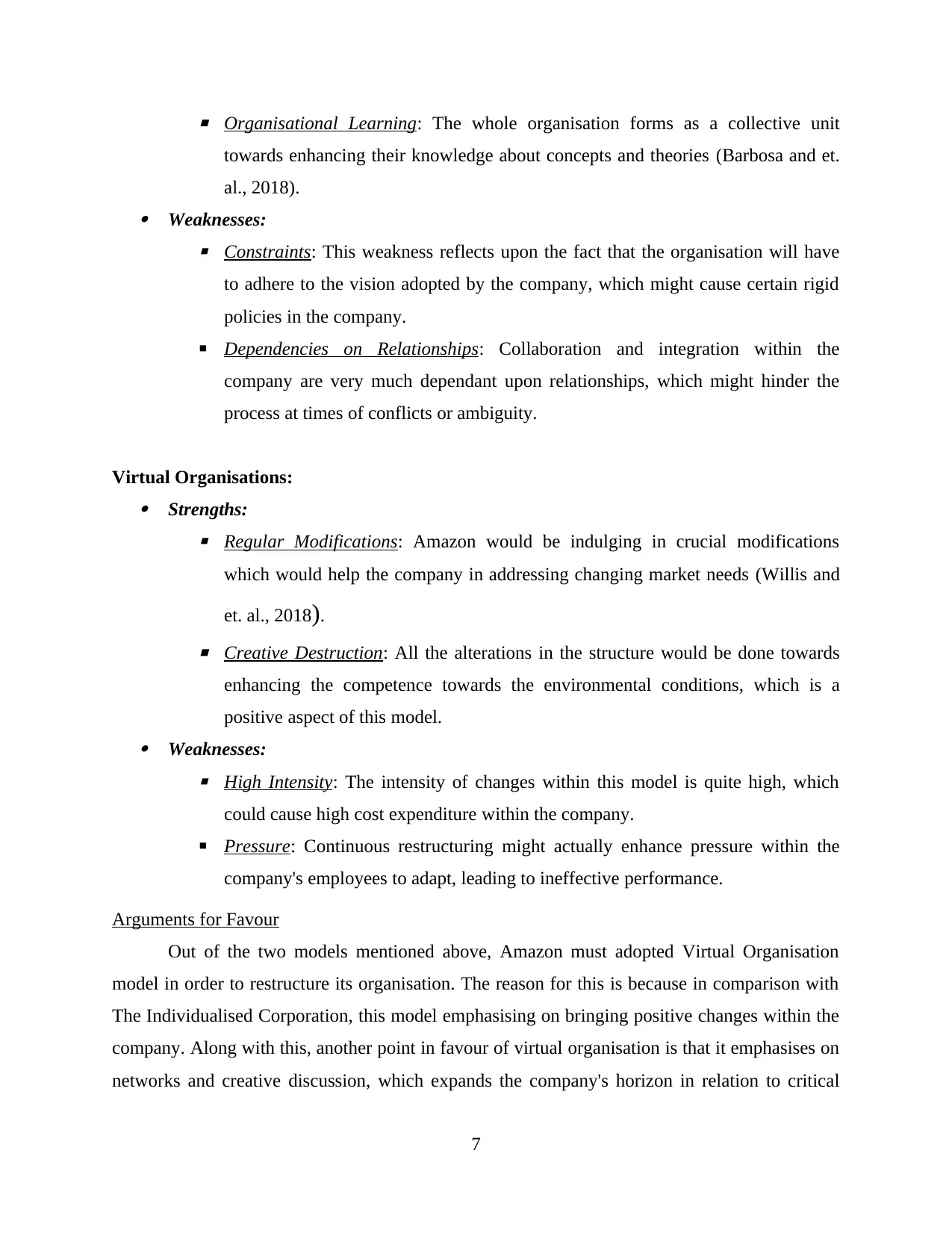
▪ Organisational Learning: The whole organisation forms as a collective unit
towards enhancing their knowledge about concepts and theories (Barbosa and et.
al., 2018). Weaknesses:
▪ Constraints: This weakness reflects upon the fact that the organisation will have
to adhere to the vision adopted by the company, which might cause certain rigid
policies in the company.
▪ Dependencies on Relationships: Collaboration and integration within the
company are very much dependant upon relationships, which might hinder the
process at times of conflicts or ambiguity.
Virtual Organisations: Strengths:
▪ Regular Modifications: Amazon would be indulging in crucial modifications
which would help the company in addressing changing market needs (Willis and
et. al., 2018).
▪ Creative Destruction: All the alterations in the structure would be done towards
enhancing the competence towards the environmental conditions, which is a
positive aspect of this model. Weaknesses:
▪ High Intensity: The intensity of changes within this model is quite high, which
could cause high cost expenditure within the company.
▪ Pressure: Continuous restructuring might actually enhance pressure within the
company's employees to adapt, leading to ineffective performance.
Arguments for Favour
Out of the two models mentioned above, Amazon must adopted Virtual Organisation
model in order to restructure its organisation. The reason for this is because in comparison with
The Individualised Corporation, this model emphasising on bringing positive changes within the
company. Along with this, another point in favour of virtual organisation is that it emphasises on
networks and creative discussion, which expands the company's horizon in relation to critical
7
towards enhancing their knowledge about concepts and theories (Barbosa and et.
al., 2018). Weaknesses:
▪ Constraints: This weakness reflects upon the fact that the organisation will have
to adhere to the vision adopted by the company, which might cause certain rigid
policies in the company.
▪ Dependencies on Relationships: Collaboration and integration within the
company are very much dependant upon relationships, which might hinder the
process at times of conflicts or ambiguity.
Virtual Organisations: Strengths:
▪ Regular Modifications: Amazon would be indulging in crucial modifications
which would help the company in addressing changing market needs (Willis and
et. al., 2018).
▪ Creative Destruction: All the alterations in the structure would be done towards
enhancing the competence towards the environmental conditions, which is a
positive aspect of this model. Weaknesses:
▪ High Intensity: The intensity of changes within this model is quite high, which
could cause high cost expenditure within the company.
▪ Pressure: Continuous restructuring might actually enhance pressure within the
company's employees to adapt, leading to ineffective performance.
Arguments for Favour
Out of the two models mentioned above, Amazon must adopted Virtual Organisation
model in order to restructure its organisation. The reason for this is because in comparison with
The Individualised Corporation, this model emphasising on bringing positive changes within the
company. Along with this, another point in favour of virtual organisation is that it emphasises on
networks and creative discussion, which expands the company's horizon in relation to critical
7

analysis itself and its capabilities and further modify the same to ensure betterment. In
connection with Amazon, its structure is quite rigid which refrains the company in adapting to
environmental changes. Hence, this model would be very much suitable towards restructuring
the company and ensure effectiveness within the same (Hughes, Kinder and Cooper, 2019).
Influence of Organisational Structure on its Culture
Organisational structure has a big influence within the culture of a company. This is
because, the belief systems and norms of the firm are shaped up by the structure of the
organisation. With respect to Amazon, this influence is reflected by certain aspects. For instance,
the structure of Amazon reflects that the company has functional-based hierarchies, which
reflects that the autonomy of decisions rests with the bosses and much less emphasis is provided
to the subordinates. In addition to this, the company has expanded to a much wider geographical
context, which influences the culture in a way that dominance of these groups is reflected within
the same (Rahman, Mordi and Nwagbara, 2018).
However, the organisation's structure must influence the company in prominent manners.
For example, it must facilitate innovation, creativity, individualism and strong emphasis on
development of networks and integration within their design. Adoption of virtual organisation
model would help the company in adhering to the same.
Recommendations
There are several recommendations which must be adopted by Amazon in relation to
effectively restructure the firm and ensuring better success. These recommendations are stated
below:
The company must indulge in a regular and constant communication related to employees
in context with the proposed change.
Training must also be constant as adoption of virtual organisation model would require
the company in implementing regular and ongoing technological advancements within
firm's regular operations.
PART 2
How Leadership Development and Employee Motivation could be implemented in Amazon
To facilitate any change, it is required to appropriately and effectively develop leadership
and employee motivation within the company to facilitate the change rather then resisting the
8
connection with Amazon, its structure is quite rigid which refrains the company in adapting to
environmental changes. Hence, this model would be very much suitable towards restructuring
the company and ensure effectiveness within the same (Hughes, Kinder and Cooper, 2019).
Influence of Organisational Structure on its Culture
Organisational structure has a big influence within the culture of a company. This is
because, the belief systems and norms of the firm are shaped up by the structure of the
organisation. With respect to Amazon, this influence is reflected by certain aspects. For instance,
the structure of Amazon reflects that the company has functional-based hierarchies, which
reflects that the autonomy of decisions rests with the bosses and much less emphasis is provided
to the subordinates. In addition to this, the company has expanded to a much wider geographical
context, which influences the culture in a way that dominance of these groups is reflected within
the same (Rahman, Mordi and Nwagbara, 2018).
However, the organisation's structure must influence the company in prominent manners.
For example, it must facilitate innovation, creativity, individualism and strong emphasis on
development of networks and integration within their design. Adoption of virtual organisation
model would help the company in adhering to the same.
Recommendations
There are several recommendations which must be adopted by Amazon in relation to
effectively restructure the firm and ensuring better success. These recommendations are stated
below:
The company must indulge in a regular and constant communication related to employees
in context with the proposed change.
Training must also be constant as adoption of virtual organisation model would require
the company in implementing regular and ongoing technological advancements within
firm's regular operations.
PART 2
How Leadership Development and Employee Motivation could be implemented in Amazon
To facilitate any change, it is required to appropriately and effectively develop leadership
and employee motivation within the company to facilitate the change rather then resisting the
8
Paraphrase This Document
Need a fresh take? Get an instant paraphrase of this document with our AI Paraphraser
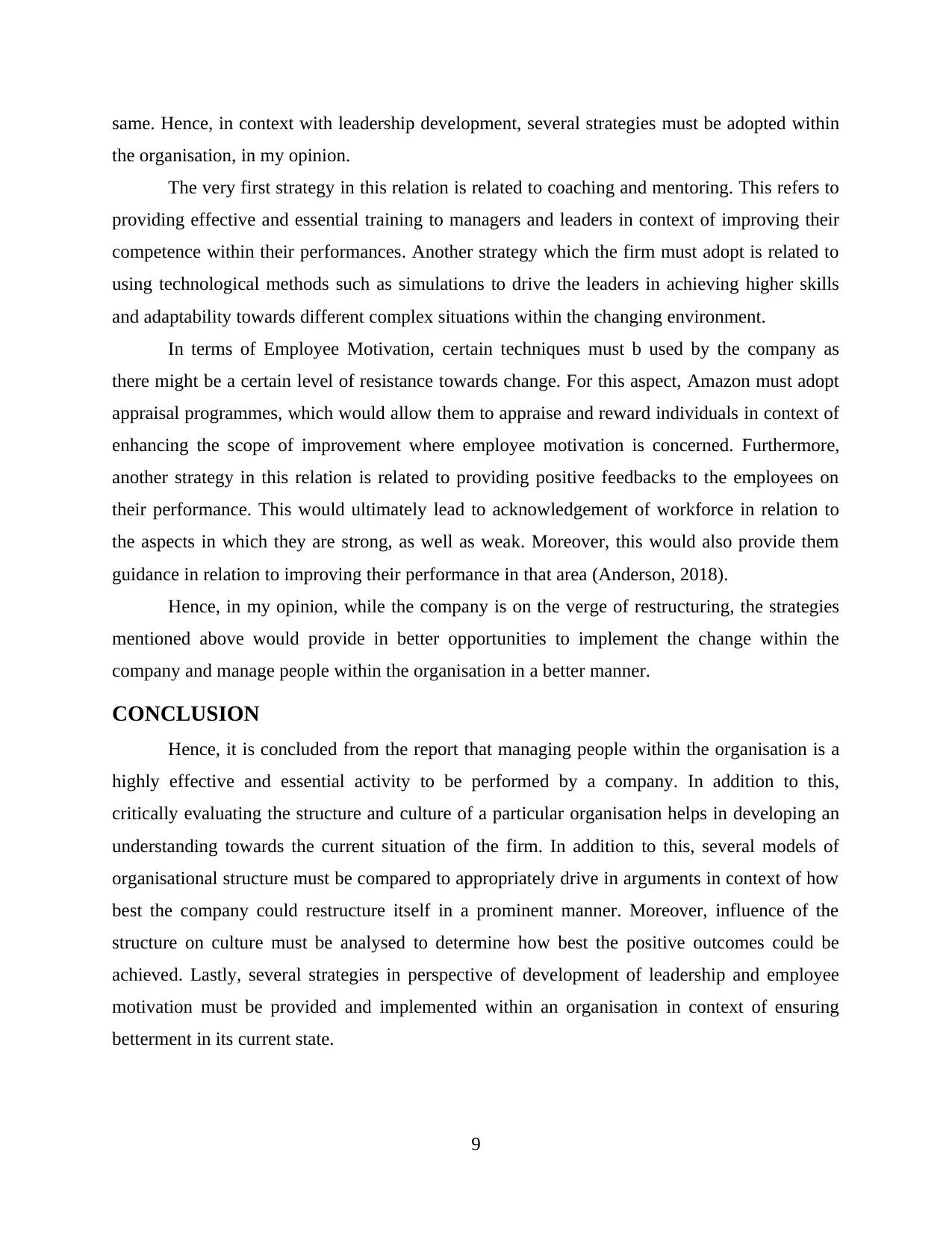
same. Hence, in context with leadership development, several strategies must be adopted within
the organisation, in my opinion.
The very first strategy in this relation is related to coaching and mentoring. This refers to
providing effective and essential training to managers and leaders in context of improving their
competence within their performances. Another strategy which the firm must adopt is related to
using technological methods such as simulations to drive the leaders in achieving higher skills
and adaptability towards different complex situations within the changing environment.
In terms of Employee Motivation, certain techniques must b used by the company as
there might be a certain level of resistance towards change. For this aspect, Amazon must adopt
appraisal programmes, which would allow them to appraise and reward individuals in context of
enhancing the scope of improvement where employee motivation is concerned. Furthermore,
another strategy in this relation is related to providing positive feedbacks to the employees on
their performance. This would ultimately lead to acknowledgement of workforce in relation to
the aspects in which they are strong, as well as weak. Moreover, this would also provide them
guidance in relation to improving their performance in that area (Anderson, 2018).
Hence, in my opinion, while the company is on the verge of restructuring, the strategies
mentioned above would provide in better opportunities to implement the change within the
company and manage people within the organisation in a better manner.
CONCLUSION
Hence, it is concluded from the report that managing people within the organisation is a
highly effective and essential activity to be performed by a company. In addition to this,
critically evaluating the structure and culture of a particular organisation helps in developing an
understanding towards the current situation of the firm. In addition to this, several models of
organisational structure must be compared to appropriately drive in arguments in context of how
best the company could restructure itself in a prominent manner. Moreover, influence of the
structure on culture must be analysed to determine how best the positive outcomes could be
achieved. Lastly, several strategies in perspective of development of leadership and employee
motivation must be provided and implemented within an organisation in context of ensuring
betterment in its current state.
9
the organisation, in my opinion.
The very first strategy in this relation is related to coaching and mentoring. This refers to
providing effective and essential training to managers and leaders in context of improving their
competence within their performances. Another strategy which the firm must adopt is related to
using technological methods such as simulations to drive the leaders in achieving higher skills
and adaptability towards different complex situations within the changing environment.
In terms of Employee Motivation, certain techniques must b used by the company as
there might be a certain level of resistance towards change. For this aspect, Amazon must adopt
appraisal programmes, which would allow them to appraise and reward individuals in context of
enhancing the scope of improvement where employee motivation is concerned. Furthermore,
another strategy in this relation is related to providing positive feedbacks to the employees on
their performance. This would ultimately lead to acknowledgement of workforce in relation to
the aspects in which they are strong, as well as weak. Moreover, this would also provide them
guidance in relation to improving their performance in that area (Anderson, 2018).
Hence, in my opinion, while the company is on the verge of restructuring, the strategies
mentioned above would provide in better opportunities to implement the change within the
company and manage people within the organisation in a better manner.
CONCLUSION
Hence, it is concluded from the report that managing people within the organisation is a
highly effective and essential activity to be performed by a company. In addition to this,
critically evaluating the structure and culture of a particular organisation helps in developing an
understanding towards the current situation of the firm. In addition to this, several models of
organisational structure must be compared to appropriately drive in arguments in context of how
best the company could restructure itself in a prominent manner. Moreover, influence of the
structure on culture must be analysed to determine how best the positive outcomes could be
achieved. Lastly, several strategies in perspective of development of leadership and employee
motivation must be provided and implemented within an organisation in context of ensuring
betterment in its current state.
9
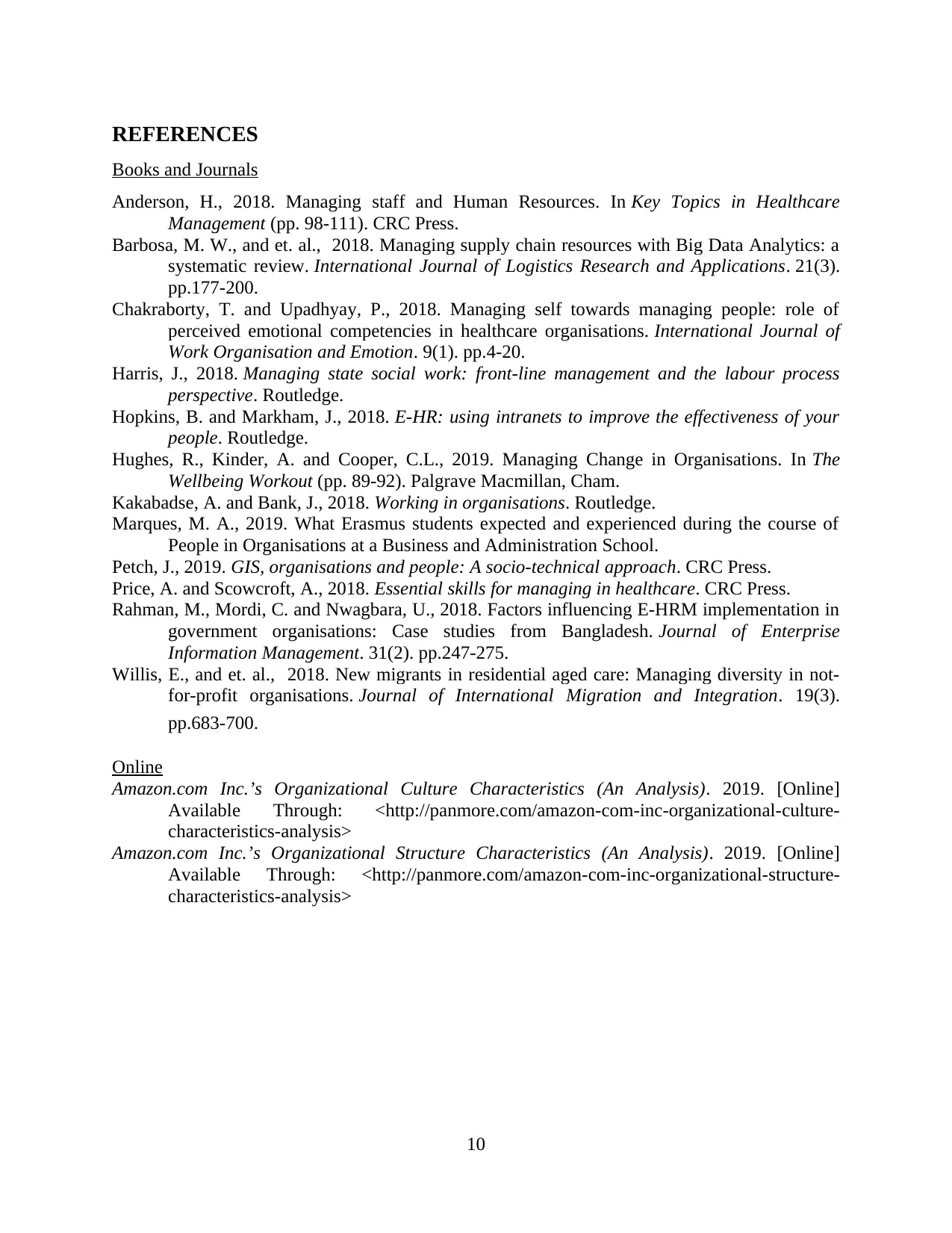
REFERENCES
Books and Journals
Anderson, H., 2018. Managing staff and Human Resources. In Key Topics in Healthcare
Management (pp. 98-111). CRC Press.
Barbosa, M. W., and et. al., 2018. Managing supply chain resources with Big Data Analytics: a
systematic review. International Journal of Logistics Research and Applications. 21(3).
pp.177-200.
Chakraborty, T. and Upadhyay, P., 2018. Managing self towards managing people: role of
perceived emotional competencies in healthcare organisations. International Journal of
Work Organisation and Emotion. 9(1). pp.4-20.
Harris, J., 2018. Managing state social work: front-line management and the labour process
perspective. Routledge.
Hopkins, B. and Markham, J., 2018. E-HR: using intranets to improve the effectiveness of your
people. Routledge.
Hughes, R., Kinder, A. and Cooper, C.L., 2019. Managing Change in Organisations. In The
Wellbeing Workout (pp. 89-92). Palgrave Macmillan, Cham.
Kakabadse, A. and Bank, J., 2018. Working in organisations. Routledge.
Marques, M. A., 2019. What Erasmus students expected and experienced during the course of
People in Organisations at a Business and Administration School.
Petch, J., 2019. GIS, organisations and people: A socio-technical approach. CRC Press.
Price, A. and Scowcroft, A., 2018. Essential skills for managing in healthcare. CRC Press.
Rahman, M., Mordi, C. and Nwagbara, U., 2018. Factors influencing E-HRM implementation in
government organisations: Case studies from Bangladesh. Journal of Enterprise
Information Management. 31(2). pp.247-275.
Willis, E., and et. al., 2018. New migrants in residential aged care: Managing diversity in not-
for-profit organisations. Journal of International Migration and Integration. 19(3).
pp.683-700.
Online
Amazon.com Inc.’s Organizational Culture Characteristics (An Analysis). 2019. [Online]
Available Through: <http://panmore.com/amazon-com-inc-organizational-culture-
characteristics-analysis>
Amazon.com Inc.’s Organizational Structure Characteristics (An Analysis). 2019. [Online]
Available Through: <http://panmore.com/amazon-com-inc-organizational-structure-
characteristics-analysis>
10
Books and Journals
Anderson, H., 2018. Managing staff and Human Resources. In Key Topics in Healthcare
Management (pp. 98-111). CRC Press.
Barbosa, M. W., and et. al., 2018. Managing supply chain resources with Big Data Analytics: a
systematic review. International Journal of Logistics Research and Applications. 21(3).
pp.177-200.
Chakraborty, T. and Upadhyay, P., 2018. Managing self towards managing people: role of
perceived emotional competencies in healthcare organisations. International Journal of
Work Organisation and Emotion. 9(1). pp.4-20.
Harris, J., 2018. Managing state social work: front-line management and the labour process
perspective. Routledge.
Hopkins, B. and Markham, J., 2018. E-HR: using intranets to improve the effectiveness of your
people. Routledge.
Hughes, R., Kinder, A. and Cooper, C.L., 2019. Managing Change in Organisations. In The
Wellbeing Workout (pp. 89-92). Palgrave Macmillan, Cham.
Kakabadse, A. and Bank, J., 2018. Working in organisations. Routledge.
Marques, M. A., 2019. What Erasmus students expected and experienced during the course of
People in Organisations at a Business and Administration School.
Petch, J., 2019. GIS, organisations and people: A socio-technical approach. CRC Press.
Price, A. and Scowcroft, A., 2018. Essential skills for managing in healthcare. CRC Press.
Rahman, M., Mordi, C. and Nwagbara, U., 2018. Factors influencing E-HRM implementation in
government organisations: Case studies from Bangladesh. Journal of Enterprise
Information Management. 31(2). pp.247-275.
Willis, E., and et. al., 2018. New migrants in residential aged care: Managing diversity in not-
for-profit organisations. Journal of International Migration and Integration. 19(3).
pp.683-700.
Online
Amazon.com Inc.’s Organizational Culture Characteristics (An Analysis). 2019. [Online]
Available Through: <http://panmore.com/amazon-com-inc-organizational-culture-
characteristics-analysis>
Amazon.com Inc.’s Organizational Structure Characteristics (An Analysis). 2019. [Online]
Available Through: <http://panmore.com/amazon-com-inc-organizational-structure-
characteristics-analysis>
10
1 out of 12
![[object Object]](/_next/static/media/star-bottom.7253800d.svg)





